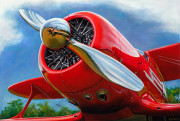Airplanes
At the height of the Great Depression, aircraft executive Walter H. Beech and airplane designer T. A. “Ted” Wells joined forces to collaborate on a project to produce a large, powerful, and fast cabin biplane built specifically for the business executive.
The Beechcraft Model 17 airplane, popularly known as the “Staggerwing” was first flown on November 4, 1932. The Model 17’s unusual negative stagger wing configuration (the upper wing staggered behind the lower) and unique shape maximized pilot visibility while negligibly reducing interference between the wings.
In the mid-1930s, Beech undertook a major redesign of the aircraft, to create the Model D17 Staggerwing. The D17 featured a lengthened fuselage that improved the aircraft’s handling characteristics by increasing control leverage and the ailerons were relocated to the upper wings, eliminating interference with the flaps. Braking was improved with a foot-operated brake linked to the rudder pedals.
The King Air family is part of a line of twin-turboprop airplanes produced by Beechcraft. The King Air line comprises a number of models that have been divided into two families; the Model 90 and 100 series are known as King Airs, while the Model 200 and 300 series were originally marketed as Super King Airs.
The Blue Angel is flown by the United States Navy’s flight demonstration squadron, with aviators from the Navy and Marines. The Blue Angels team was formed in 1946, making it the second oldest formal flying aerobatic team (under the same name) in the world, after the French Patrouille de France formed in 1931.
The Blue Angels’ six demonstration pilots fly the F/A-18 Hornet airplane, typically in more than 70 shows at 34 locations throughout the United States each year, where they still employ many of the same practices and techniques used in their aerial displays in 1946. Since 1946, the Blue Angels Airplanes have flown for more than 260 million spectators.





